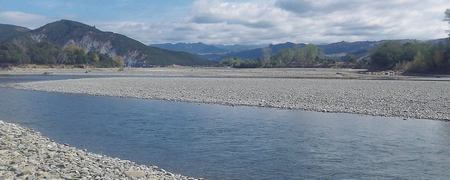Healthy land, healthy rivers, healthy people

Erosion over many years has resulted in high sediment loading of rivers in the Waiapu Catchment.
A unique Memorandum of Understanding signed last year between the Ministry for Primary Industries, Te Runanga o Ngāti Porou (TRONPnui) and Gisborne District Council (GDC) has marked the beginning of a long journey to restore the health of the Waiapu Catchment. The catchment, situated on New Zealand’s East Coast, is struggling to overcome years of landscape degradation, poverty and climate change, compromising the ability of local people to revitalise their existing way of life.
At the heart of the MoU is research undertaken by Scion’s Forest Systems Team, expanding on work they did in 2012 to explore the factors contributing to this decline. Both projects are now deeply embedded in the relationship between the Crown and Ngāti Porou in an historic 100 year Waiapu Restoration Partnership formed to restore the health of the land, the river and its people in what is widely acknowledged to be a complex and inter-generational process.
“Communities in the catchment and Ngāti Porou in particular, have been dealing with the effects of environmental, social and economic shock for over a century,” says team manager and project leader Tim Barnard. “Heavy deforestation has led to years of erosion, and the Waiapu River has the highest level of sediment loading of any river in the country. The flow on effect for the community is huge with many people leaving the area to seek opportunities for a better future, elsewhere.
“Without intervention, the social, economic and biophysical factors that have contributed to the present state of the catchment will continue into the future, and climate change is expected to add further stressors.”
As Tim explains, the leadership of change rests within the community itself, and the governance of Ngāti Porou. “To improve the resilience of the catchment to further shock, the future must be built on the strengths of the community and its current realities and resources. Partnerships with external agencies will also play an important role in bringing additional knowledge and resources into the community.”
The afforestation of highly erodible land using conventional radiata pine forestry will be high priority for the partnership, but it is expected new forestry models and diverse land use will play a major role in building community resilience and cultural sustainability for the future. To achieve this in an holistic way and one which is culturally relevant, says Tim, requires a level of political sophistication that arguably has not yet been achieved anywhere in New Zealand.
At the final hui of the project in Gisborne, Scion’s final research report was welcomed by MPI, TRONPnui and GDC, being cited as an exemplar for future engagement with Māori. The restoration partnership adopted many of the recommendations of Scion’s earlier work done in 2012, and won the MPI Director General’s Award for Partnership this year.
According to Ngāti Porou researcher, Tui Warmenhoven, “This research project is a model for other New Zealand communities of how science and Mātauranga Māori can be integrated to bring about meaningful relationship building, stakeholder commitment and pathways to ongoing research, partnership and progress.”
For further information
Contact Tim Barnard at Show email
www.mpi.govt.nz/funding-and-programmes/natural-resources/restoring-the-waiapu-catchment
